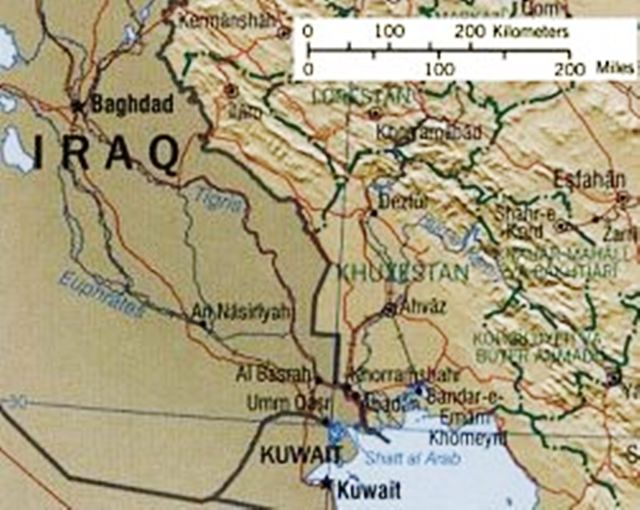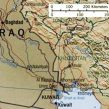
Iraqi Militants Encourage People of Khuzestan to Launch Jihad against Iran
Publication: Terrorism Monitor Volume: 9 Issue: 37

Influenced by the upheaval that has stricken many Arab countries in the Middle East and North Africa, the people of southwest Iran’s Khuzestan Province have tried to start their own protest movement. Khuzestan is inhabited by a majority of Arabs and is home to more than 80% of Iran’s oil reserves. In the Arabic literature of the political and cultural organizations of the province, the area is called al-Ahwaz. [1]
The calls for an uprising in the province earlier this year tried to emulate the April 2005 protests in Khuzestan, which were quelled by the use of violence by Iranian authorities. The Iranian state media reported no news from the province during the current protests but opposition sources claimed that the Iranian Revolutionary Guards opened fire on the protesters and killed three people. It was also reported that dozens were arrested (Alarab.net, April 18).
Although the movement did not develop into anything like the uprising of 2005, it attracted the attention of Iraqi Islamist insurgent groups. The Salafi-Jihadi Ansar al-Islam (AI) group released a communiqué named “Message of solidarity with our brothers in Ahwaz,” calling on them to unify their efforts and launch a jihad against Iran (alboraq.info, May 11).Cooperation between the Iraqi insurgents and Ahwazi groups reportedly started soon after the invasion of Iraq in 2003. During the 2005 uprising in Khuzestan, the first agreement between activists from the province and Iraqi insurgents became known and a series of bombs struck Iranian government buildings and targets the following years (Islammemo.cc, June 12, 2005).
Arabs in the province accuse successive Iranian governments of pursuing a policy aimed at changing the demographic nature of the region by encouraging non-Arab Iranians to migrate to the province in large numbers. They are also critical of changes in the province’s borders that have seen southern areas with a majority Arab population detached and areas with Arab minority populations added in the north.
In an interview with the Jamestown Foundation, the leader of the disbanded Hizb al-Nahda al-Arabi al-Ahwazi (Ahwazi Arab Renaissance Party), Sabah al-Mossawi, revealed that there were Ahwazi fighters who had joined the Iraqi insurgency: “They went to fight the occupation [i.e. Coalition forces] but also to fight the Iranian-backed parties. They mainly joined the Islamic Army in Iraq and the Ba’ath party.”
Throughout centuries of conflict between Iran and the Ottoman Empire, the Khuzestan region managed to maintain a degree of relative independence, being ruled by a series of local tribal leaders. The last of these was toppled by the Iranian authorities in 1925 and the area came under the direct control of Tehran. After the Islamic revolution of 1979, the community’s demands for more rights and recognition of their distinct identity were not accepted by the new government. Subsequently a large-scale uprising broke out in the province. The Iranian authorities in turn repressed the protest movement ruthlessly and the area came under military rule. Iraqi-backed organizations launched a series of attacks on military and civilian targets during the uprising. The Ahwazi issue attracted international attention when a group of Ahwazi gunmen belonging to the Democratic Revolutionary Front for the Liberation of Arabistan (DRFLA) occupied the Iranian embassy in London in 1980 and took hostages. After a six-day siege of the embassy by police, the gunmen killed one hostage, leading to a successful raid to release the hostages in the embassy by the British Special Air Service (SAS), a Special Forces Regiment.
There are various opposition groups which claim to represent the Arab population of Khuzestan. All of them are banned in Iran but operate in exile while claiming to have an active presence in the province. However the most prominent group that claims to be militarily active is the Ba’athist Arab Struggle Movement to Liberate Ahwaz (ASMLA) and its armed wing, the Martyr Mohye al-Din al-Nasir Brigade (MMDNB). The latter’s strategy is to target oil production facilities in the province as a means of weakening the Iranian economy, which depends heavily on the oil of Khuzestan Province. In 2007 the MMDNB recognized Izzat Ibrahim al-Douri as the new leader of the Iraqi Ba’ath party (Albasrah.net, June 24, 2007)
The majority of the people of Khuzestan are Sh’ia Muslims but there has been a growing movement among them to convert to Sunni Islam. This trend has escalated significantly over the last few years, driven mainly by a local identity problem. Resentment of Iran by some Shi’a Ahwazis is reflected in a number or ways, including a rejection of the Shi’a faith. None of the prominent Shi’a clerics in Iran or Iraq have clearly supported the Ahwazi cause. The most senior Ahwazi cleric and the most influential community leader, Shaykh Muhammad Tahir al-Khaqani, was forced to leave Khuzestan after the uprising of 1979 and put under house arrest in Qom until his death in 1986. No other local cleric emerged to preserve the Shi’a-Arab nationalist identity of the population.
Salafi-Jihadi groups from Iraq regard the conversions to Sunni Islam in Khuzestan-Ahwaz as genuine and are encouraging the integration of Ahwazi converts in the international jihadi movement. According to the AI communiqué: “The origin of the people of Ahwaz is that they are a Sunni nation. The Iranian occupation has imposed Persian and Shi’a culture on them. The policy of Persianization is based on the Rafidah faith (i.e. Shi’a Islam). Therefore there should be a clear distinction of the right faith (i.e. Sunni Islam). This distinction should be the foundation to be relied on for achieving political and geographical independence for the state of Ahwaz.” The AI message went on to set a strategy for the confrontation in Khuzestan, calling for its people to build a Sunni religious and political leadership: “There should be a unified Sunni-Jihadi movement in Ahwaz and it should join the global jihad” (Alboraq.info, May11).
The AI communiqué is very important. It is picking up on a growing trend and trying to direct it towards a jihadi goal. So far the revolutionary movements in Khuzestan have been based on the community’s Arab identity within a Persian and Shi’a Iran. With the increase of conversions to Sunni Islam among the population, it is not possible to rule out that a base for a Salafi-Jihadi organization could be established in the province. Such a development might well change the relationship between Salafi-Jihadi groups and Iran. The former have avoided a direct confrontation with Tehran so far, despite the often severe confrontations between the Shi’a and Sunni communities in the Middle East. Iraqi Sunni Islamists will be heavily involved in such a struggle, putting the Salafi-Jihadists at the centre of one of the most significant geo-political conflicts in the region.
Notes:
1. Khuzestan was historically named Arabistan (the land of the Arabs). In 1935 the Iranian government of Shah Reza Pahlavi renamed it Khuzestan i.e. “the Land of the Khuzis,” referring to the ancient name used for sugar cane farmers in the ancient kingdom of Susa.
Local Arab people call the province al-Ahwaz and emphasize its history of independence under Arab rulers since the Arab invasion of 639 C.E. Ahwaz is also the name of the Khuzestan capital.





